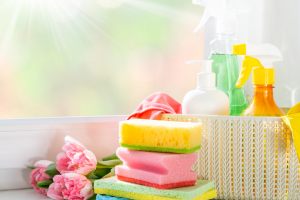11 bonkers things we’ve learned from the Marie Kondo series

Everyone knows of Marie Kondo; whether it’s just those tidying books that sold an insane amount of copies (11 million across 40 countries), the KonMarie Method itself or, since it dropped on Netflix, via the series Tidying Up With Marie Kondo which shows the transformative effect of Kondo on people’s homes.
Somehow the programme has proven mass-appeal; for people who love, hate and feel indifferent towards tidying. Possibly due to her infectious, interested, empathetic and non-judgemental (even when faced with a wall of vintage baseball cards) enthusiasm for helping the families clear their homes and her relationship with smiley translator Marie Iida, who does a stellar job of encapsulating Marie Kondo’s child-like charm.
Though her message is simple — only keep stuff that ‘sparks joy’ (a.k.a get rid of redundant crap, but not in a way you find forced or stressful but by ‘confirm[ing] how you feel about each and every item you possess’) and ensure it’s stored in a way you can see it all clearly, the change it makes to people’s lives is remarkable.
View this post on Instagram
Here are some of our favourite tips from the Netflix serious; some for usefulness and some for ridiculous-but-usefulness…
1. Store things in plastic boxes, so you can see what is inside them.
2. Get all your stuff out, in order to then tidy it up properly, so you can see everything you have in one place.
3. Tidy in a particular order; clothes, books, documents, miscellaneous items (known as ‘komono’ in Japanese) and lastly sentimental items.
4. If you’re having trouble getting the ‘spark joy’ thing — for example, if you’re not that fussed by clothes, so you just wear them as it’s more socially acceptable than being naked — move onto a different category that you think will trigger that kind of feeling so you get used to it, before returning to your challenging category.
5. Don’t get freaked out by a fitted bed sheet. Just lie it on the floor and fold it rounded corner to rounded corner, then fold again.
6. Make sure items have a home — so little cardboard boxes, which counterintuitively feel like something you should chuck, can be useful for using to divide kitchen drawers and other storage boxes, for a kind of storage box inception.
7. Stack things, like memory cards, upright so you can see them clearly.
View this post on Instagram
8. If you have crockery and kitchenware you use less often, store it on the higher shelves you find trickier to reach, so the things you use most often are easy to access.
9. Be grateful for your house, however messy and hectic, and ‘the goods that support [you]’. And thank items before throwing them onto the charity shop pile.
10. If you keep books just because you think you will or feel like you should read them, rather than enjoying their presence, get rid. (This was a contentious point, blowing up on social media, as watchers misunderstood and felt personally victimised about their cultured walls of books.)
11. Don’t pressure those you live with, whether friends or family, to throw stuff out; it’s a personal decision and one that will lose its charm if forced.
The crux of the technique is being conscious about what you have and, at a time when the general household is drowning under crap, it’s a normal thing to face up to; not for Channel 4 doc-style hoarders, but normal people.
In short, if you haven’t watched it because you think it sounds boring. You’re wrong.








